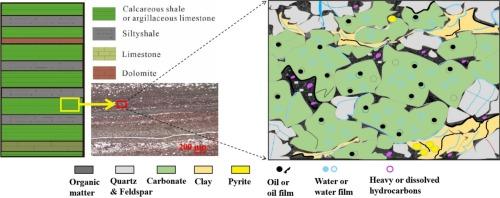含油气页岩润湿性评价方法、控制因素及应用综述
IF 7.2
1区 地球科学
Q1 GEOSCIENCES, MULTIDISCIPLINARY
引用次数: 0
摘要
由于含油气页岩的细粒结构、非均质矿物学和复杂的孔隙裂缝网络,对其润湿性进行评估是一项重大挑战。综述了不同沉积相含油气页岩润湿性测试方法、影响因素及润湿性特征。主要结果包括:(1)虽然接触角、自吸、核磁共振、量热、电镜等分析方法已被广泛采用,但尚未形成一个普遍接受的标准。通常被引用的中性润湿性,既表示亲水性,也表示疏水性,是高度可变的,并受到页岩固有性质和实验不确定性的影响。(2)页岩的润湿性受基质组成、表面官能团、微观结构特征以及相互作用流体(包括地层水和烃类)的物理和热力学性质的影响。构造埋藏、成岩演化、热成熟、生烃等地质因素使润湿性特征进一步复杂化。不同沉积相的页岩表现出明显差异:海相页岩主要受有机孔隙发育和矿物组成的影响;过渡性页岩的无机孔隙裂缝和有机质类型;而湖相页岩则以无机孔缝体系和矿物学特征为主。(3)多尺度孔隙网络中复杂的流固相互作用决定了非均质润湿性,从而影响油气的分布、滞留和运移。未来的研究应侧重于储层条件下的原位润湿性表征(t & P条件、流体性质等)、近井动态润湿性以及外部流体侵入的影响,以增强预测模型和优化油气开采策略。本文章由计算机程序翻译,如有差异,请以英文原文为准。

Wettability evaluation of hydrocarbon-bearing shales: A review of methods, controlling factors, and application
Evaluating wettability in hydrocarbon-bearing shales poses significant challenges due to their fine-grained structure, heterogeneous mineralogy, and intricate pore-fracture networks. This paper reviews the wettability testing methods, influencing factors, and wettability characteristics of hydrocarbon-bearing shales from different sedimentary facies. The main results include: (1) Although analytical methods such as contact angle, spontaneous imbibition, nuclear magnetic resonance, calorimetry, electron microscope, etc. have been employed, a universally accepted standard remains elusive. The oft-cited neutral wettability, indicating both hydrophilic and hydrophobic characteristics, is highly variable and influenced by the intrinsic shale properties and experimental uncertainties. (2) Shale wettability is governed by the matrix composition, surface functional groups, and microstructural features, as well as by the physical and thermodynamic properties of interacting fluids, including formation water and hydrocarbons. Geological factors, such as tectonic burial, diagenetic evolution, thermal maturation, and hydrocarbon generation, further complicate wettability characteristics. Shales from different sedimentary facies display marked differences: marine shales are predominantly affected by organic pore development and mineral composition; transitional shales by inorganic pore-fractures and organic matter type; and lacustrine shales by inorganic pore-fracture systems and mineralogy characteristics. (3) The complex fluid–solid interactions within multi-scale pore networks dictate heterogeneous wettability, which in turn influences hydrocarbon distribution, retention, and migration. Future studies should focus on in-situ wettability characterization under reservoir conditions (T&P conditions, fluid property, etc.), dynamic wettability near wellbores, and the effects of external fluid intrusion to enhance predictive models and optimize hydrocarbon extraction strategies.
求助全文
通过发布文献求助,成功后即可免费获取论文全文。
去求助
来源期刊

Gondwana Research
地学-地球科学综合
CiteScore
12.90
自引率
6.60%
发文量
298
审稿时长
65 days
期刊介绍:
Gondwana Research (GR) is an International Journal aimed to promote high quality research publications on all topics related to solid Earth, particularly with reference to the origin and evolution of continents, continental assemblies and their resources. GR is an "all earth science" journal with no restrictions on geological time, terrane or theme and covers a wide spectrum of topics in geosciences such as geology, geomorphology, palaeontology, structure, petrology, geochemistry, stable isotopes, geochronology, economic geology, exploration geology, engineering geology, geophysics, and environmental geology among other themes, and provides an appropriate forum to integrate studies from different disciplines and different terrains. In addition to regular articles and thematic issues, the journal invites high profile state-of-the-art reviews on thrust area topics for its column, ''GR FOCUS''. Focus articles include short biographies and photographs of the authors. Short articles (within ten printed pages) for rapid publication reporting important discoveries or innovative models of global interest will be considered under the category ''GR LETTERS''.
 求助内容:
求助内容: 应助结果提醒方式:
应助结果提醒方式:


